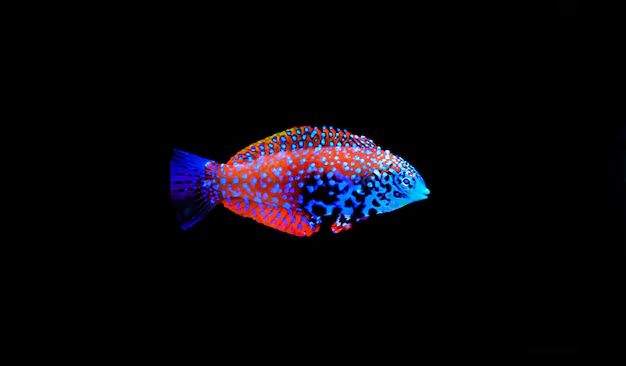
Understanding the Blue Star Leopard Wrasse: Care and Considerations
The Blue Star Leopard Wrasse, also known as the Divided Wrasse or Vermiculite Wrasse among other names, is a captivating species within the Macropharyngodon genus, which comprises thirteen distinct species of leopard wrasses. This species exhibits sexual dichromatism, meaning males and females display different colorations. Intriguingly, all leopard wrasses are protogynous hermaphrodites, starting life as females and potentially transitioning to males based on maturity and social hierarchy.
Appearance and Behavior
Female M. bipartitus are particularly striking, featuring a palette that includes a yellow to green mouth and head, a reddish-orange body, orange to yellow fins, and a distinctive blue/black area around the abdomen. Their complex, pearlescent markings of white, orange, and light blue make them a standout addition to any tank. Males are equally impressive with a brown-to-red body accented by vibrant green and blue stripes and blotches, highlighted with black outlines.
Natural Habitat and Diet
In the wild, these wrasses are found from the Western Indian Ocean to the Maldives, inhabiting lagoon and sheltered seaward reefs up to about 98 feet deep. Their diet primarily consists of foraminiferans (shelled protozoa) and small snails, which they meticulously pick from the substrate. Juveniles and females typically form small groups, or harems, with a mature male overseeing the group.
Aquarium Requirements
To successfully keep this species, especially in a reef setting, several conditions must be met:
- Tank Covering: Given that all wrasses are known jumpers, it’s critical to cover your tank. A 1/4-inch clear-net screen is ideal as it allows light penetration without posing an escape risk for the fish.
- Tank Mates: Opt for peaceful community fish to avoid aggressive interactions.
- Feeding: These active fish require multiple daily feedings of meaty foods to stay healthy.
- Environment: Provide plenty of rockwork with caves and hiding spots to reduce stress. This is particularly important in tanks with multiple wrasses.

Special Care for Macropharyngodon
Leopard wrasses, including M. bipartitus, have specific needs:
- Established Tank: An established aquarium with plenty of live rock and microfauna is crucial as these wrasses continuously hunt for live food.
- Sandy Substrate: A sand bed of at least two inches is necessary for these wrasses to bury themselves at night or when threatened.
Acclimation and Socialization
Introducing a Blue Star Leopard Wrasse to your tank should be done with care. A socialization/acclimation box is recommended to allow existing tank mates to safely interact with the new fish, minimizing the risk of aggression.
Selection and Captive Care
When selecting this species, especially from a local fish store, ensure the fish is healthy—look for clear eyes, no damage to the body or fins, and normal breathing. Observe its behavior for any signs of distress or illness, such as twitching or scratching against objects, which could indicate parasites. It’s also crucial to confirm that the fish is eating well, accepting and not spitting out prepared foods.
In captivity, their diet should include a variety of high-quality frozen and dried meaty foods, which can help ease the transition from live foods. Initially, don’t be alarmed if the wrasse buries itself in the sand for extended periods; this is a normal acclimation behavior.
Community and Compatibility
Blue Star Leopard Wrasses can be kept singly or in pairs, and in larger systems, as part of a harem consisting of one male and several females. They can coexist with other peaceful, reef-compatible wrasses and are generally suitable for modern, well-maintained reef aquariums.
Despite their beauty and the fascinating dynamics they bring to a tank, Blue Star Leopard Wrasses are best suited for experienced aquarists who can meet their specific care requirements and manage their sensitive acclimation and socialization needs effectively. With proper care, they make a stunning and lively addition to any advanced hobbyist’s aquarium.




